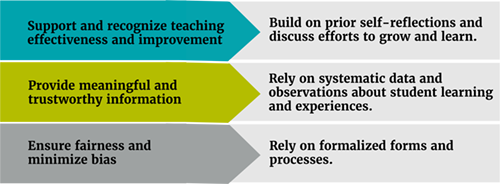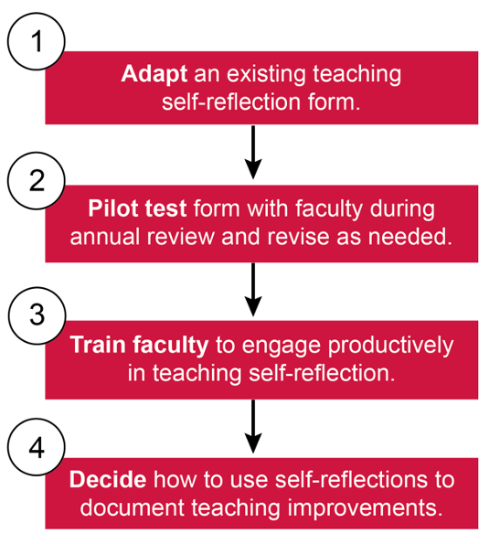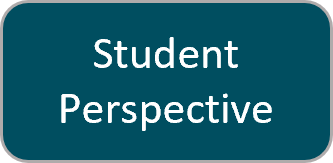Instructor Self Perspective
The instructor self perspective involves written documentation of systematic teaching self-reflection. The aim of self-reflection is to improve teaching over time by identifying challenges and systematically considering information (including evidence from student and peer perspectives).
Using the instructor self perspective can achieve important goals (below left) via robust practices (below right).

Click for a text version of the Instructor Self Perspective graphic. (PDF)
Decision Guide
This section provides guiding questions that departments can consider as they develop processes for teaching self-reflection. Click on each title to expand (or collapse) each box.
Having standard processes ensures fairness across faculty and produces more trustworthy information on which to make evaluations.
- What teaching self-reflection form will the department use?
- Will teaching self-reflections focus on tackling teaching challenges, rather than just describing accomplishments?
- Will teaching self-reflections include the analysis of information about student learning and experiences?
- Will expectations vary by experience, including teaching experience and experience with systematic self-reflection?
Designing processes to document growth recognizes effort toward improvement, rather than just excellence:
- Will self-reflections discuss how faculty built on prior self-reflections, including the outcomes of planned improvements?
- Will self-reflections discuss learning from successes and failures in teaching?
Providing training and resources for faculty ensures fairness and will produce more useful information.
- How will faculty be trained to engage in and document systematic teaching self-reflection?
- When and how will expectations for teaching self-reflection be examined to improve them?
Departmental Quick Start Guide

UGA Feature: The Department of Mathematics uses Self-Reflection
Who & Why? The Department of Mathematics adopted a new self-reflection process to support faculty in improving their teaching, and to provide additional evidence of teaching commitment for annual review.
When & How? The department developed and refined the use of teaching self-reflection over a few years. Previously teaching self-reflection had not been a departmental expectation. Over a few years, the department shifted from no expectation for self-reflection, to an invitation to submit a written self-reflection, to an expectation to submit a written teaching self-reflection as part of annual review.
What? The Department of Mathematics asks faculty to submit a written teaching self-reflection as part of annual review. The Department Head provides a template that asks for a 1-page description of systematic self-reflection, which faculty may choose to use. Faculty also receive a detailed guide about the self-reflection process.
Additional Resources
Example processes for teaching self-reflection:
- Evidence-Based Self-Reflection Form (.docx) (University of Georgia)
- Self-Reflection Form with Selection of Questions (.docx) (University of Colorado Boulder)
- Guide for Evaluating Teaching Self-Reflections (University of Southern California)
Guides for faculty and departments using self-reflection
- Faculty Guide for Self-Reflection (PDF) (University of Georgia)
- Guide for Advancing Teaching Evaluation (PDF), Instructor Voice (University of Georgia)



